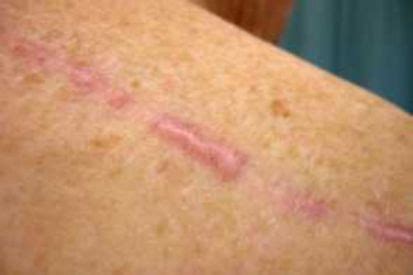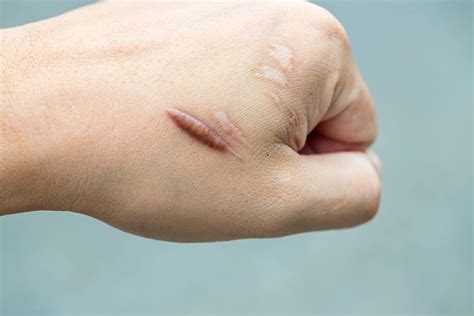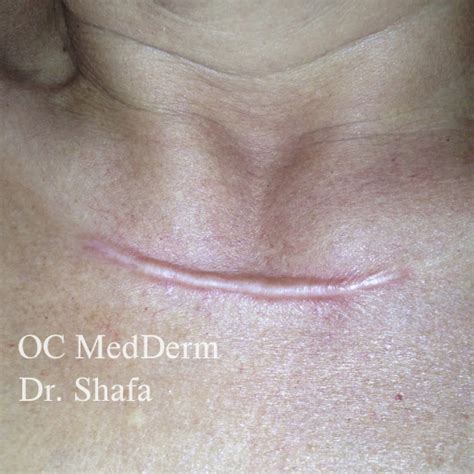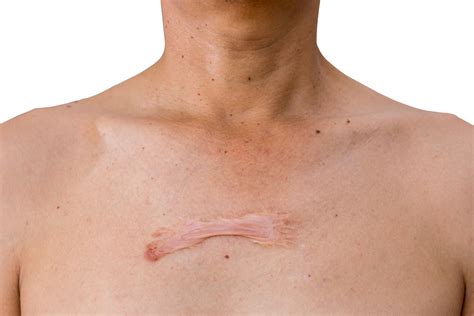Intro
Discover what keloids are, a type of raised scar tissue, and learn about keloid symptoms, causes, and treatments, including natural remedies and surgical options for removal and prevention of these stubborn skin growths.
Keloids are a type of raised, thick scarring that can occur after skin injury, such as cuts, burns, or surgical incisions. They are characterized by an overgrowth of scar tissue, which can be itchy, painful, and unsightly. Keloids can appear anywhere on the body, but they are most common on the ears, chest, back, and shoulders. Unlike regular scars, keloids do not fade over time and can continue to grow, making them a frustrating and embarrassing condition for those who experience them.
Keloids are more common in certain populations, such as people with darker skin tones, and can be triggered by a variety of factors, including genetics, skin tension, and inflammation. While keloids are not a serious health risk, they can have a significant impact on a person's self-esteem and quality of life. In addition to their physical symptoms, keloids can also cause emotional distress and anxiety, particularly if they are located in visible areas of the body.
Understanding keloids is essential for developing effective treatment strategies and preventing their occurrence. Research has shown that keloids are caused by an abnormal healing process, in which the skin produces too much collagen and other scar tissue components. This can be triggered by a variety of factors, including skin injury, inflammation, and genetic predisposition. By understanding the underlying causes of keloids, healthcare professionals can develop targeted treatments to reduce their appearance and alleviate their symptoms.
What Causes Keloids

The skin's natural healing process involves the production of collagen and other scar tissue components. In people who are prone to keloids, this process can become overactive, leading to an excessive accumulation of scar tissue. This can be triggered by a variety of factors, including skin injury, inflammation, and infection. By understanding the underlying causes of keloids, healthcare professionals can develop targeted treatments to reduce their appearance and alleviate their symptoms.
Risk Factors for Keloids
Several risk factors can increase a person's likelihood of developing keloids. These include: * Family history: People with a family history of keloids are more likely to develop them. * Skin conditions: Certain skin conditions, such as acne and eczema, can increase the risk of keloid formation. * Hormonal fluctuations: Hormonal changes, such as those that occur during pregnancy or puberty, can contribute to the development of keloids. * Skin injury: Cuts, burns, and other skin injuries can trigger the formation of keloids. * Inflammation: Chronic inflammation can increase the risk of keloid formation.Types of Keloids

Each type of keloid requires a different treatment approach, and understanding the underlying characteristics of each type is essential for developing effective treatment strategies.
Treatment Options for Keloids
Several treatment options are available for keloids, including: * Topical creams and gels: These can help reduce the appearance of keloids and alleviate their symptoms. * Steroid injections: These can help reduce inflammation and prevent further keloid growth. * Laser therapy: This can help reduce the appearance of keloids and alleviate their symptoms. * Surgical removal: This can be used to remove large or problematic keloids.Each treatment option has its advantages and disadvantages, and the most effective approach will depend on the individual's specific needs and circumstances.
Prevention of Keloids

By understanding the underlying causes of keloids and taking steps to prevent them, individuals can reduce their risk of developing these unsightly and uncomfortable scars.
Complications of Keloids
Keloids can have several complications, including: * Emotional distress: Keloids can cause significant emotional distress and anxiety, particularly if they are located in visible areas of the body. * Skin irritation: Keloids can cause skin irritation, including itching, redness, and swelling. * Infection: Keloids can become infected, particularly if they are not properly cared for. * Scarring: Keloids can cause scarring, particularly if they are not properly treated.By understanding the potential complications of keloids, individuals can take steps to prevent them and alleviate their symptoms.
Treatment Strategies for Keloids

Each treatment strategy has its advantages and disadvantages, and the most effective approach will depend on the individual's specific needs and circumstances.
Home Remedies for Keloids
Several home remedies are available for keloids, including: * Aloe vera: This can help reduce inflammation and promote healthy healing. * Tea tree oil: This can help reduce inflammation and prevent infection. * Coconut oil: This can help moisturize the skin and promote healthy healing. * Vitamin E oil: This can help reduce inflammation and promote healthy healing.By understanding the potential benefits and risks of home remedies, individuals can make informed decisions about their treatment options.
Conclusion and Next Steps

We encourage you to share your experiences and thoughts on keloids in the comments section below. Have you or someone you know struggled with keloids? What treatments have you tried, and what were the results? By sharing your stories and insights, you can help others who are struggling with keloids and promote greater awareness and understanding of this condition.
What are keloids and how do they form?
+Keloids are a type of raised, thick scarring that can occur after skin injury. They are characterized by an overgrowth of scar tissue and can be itchy, painful, and unsightly. Keloids form when the skin's natural healing process becomes overactive, leading to an excessive accumulation of scar tissue.
What are the symptoms of keloids?
+The symptoms of keloids can include itching, pain, and skin irritation. Keloids can also be unsightly and can cause emotional distress and anxiety, particularly if they are located in visible areas of the body.
How are keloids treated?
+Keloids can be treated with a variety of methods, including topical creams and gels, steroid injections, laser therapy, and surgical removal. The most effective treatment approach will depend on the individual's specific needs and circumstances.
Can keloids be prevented?
+Yes, keloids can be prevented by taking steps to reduce the risk of skin injury and promote healthy healing. This can include keeping wounds clean and dry, applying topical creams and gels, avoiding tight clothing, and protecting the skin from the sun.
What are the complications of keloids?
+Keloids can have several complications, including emotional distress, skin irritation, infection, and scarring. By understanding the potential complications of keloids, individuals can take steps to prevent them and alleviate their symptoms.
